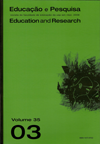Ficção científica e ensino de ciências: para além do método de 'encontrar erros em filmes'
DOI:
https://doi.org/10.1590/S1517-97022009000300008Palabras clave:
Ficção científica, Literatura, Cinema, Ensino de ciênciasResumen
Obras de ficção científica têm sido apontadas como um recurso importante para o ensino de ciências. Entretanto, mais do que um possível recurso didático para facilitar o aprendizado de ciências, a ficção científica constitui por si só uma modalidade de discurso sobre a ciência na medida em que expressa, por meio do cinema e da literatura, interesses e preocupações em torno de questões científicas presentes que influem diretamente no âmbito sociocultural. É comum, entretanto, considerar a possível qualidade didática das obras ficcionais apenas em função da suposta correção científica dos conceitos que apresenta, procedimento esse que ignora as condições de produção do discurso ficcional. Neste trabalho, propõe-se uma metodologia de análise do conteúdo de obras de ficção científica em sua relação com o conhecimento científico, que procura evidenciar, mediante elementos de análise literária e de semiótica, o processo de construção daquilo que denominamos elementos contrafactuais. Tal análise assume a obra não como um simples recurso didático, mas como um discurso regido por mecanismos ficcionais e que se vale desses mecanismos para veicular posições, ideias e debates em torno de temas científicos atuais. Como resultado, foi produzida uma categorização dos elementos construída a partir da semiótica greimasiana, empregando uma base de traços distintivos assumidos como lexemas, para a elaboração das categorias. Cada uma dessas categorias, ao representar mecanismos narrativos distintos, tem a potencialidade de uma forma de exploração diferente em termos didáticos.Descargas
Los datos de descarga aún no están disponibles.
Descargas
Publicado
2009-12-01
Número
Sección
Artículos
Licencia
Los conceptos emitidos en los artículos son de exclusiva responsabilidad de sus autores y no reflejan necesariamente la opinión de la redacción.
Está permitida la reproducción total o parcial de los trabajos, siempre y cuando se indique explícitamente la fuente.
Cómo citar
Ficção científica e ensino de ciências: para além do método de ’encontrar erros em filmes’ . (2009). Educação E Pesquisa, 35(3), 525-540. https://doi.org/10.1590/S1517-97022009000300008



